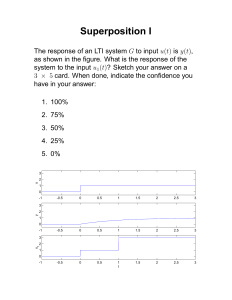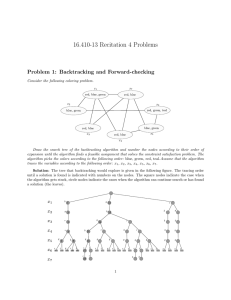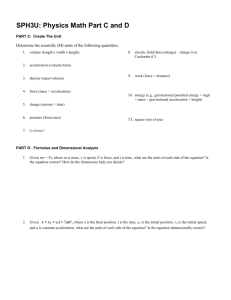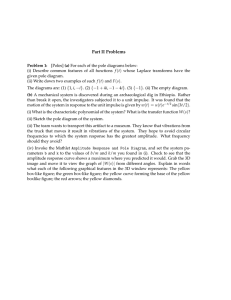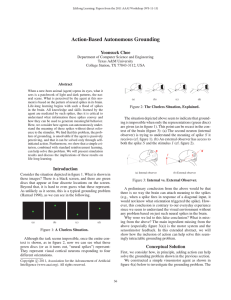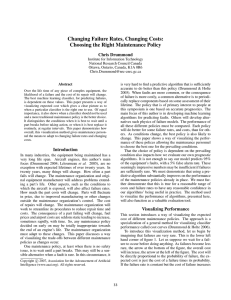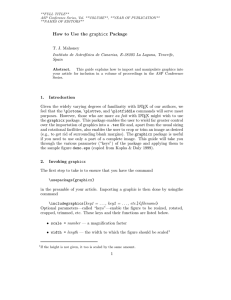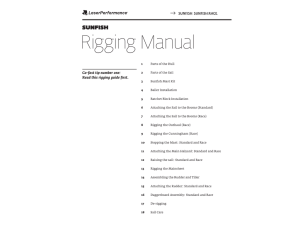. Massachusetts Institute of Technology
advertisement
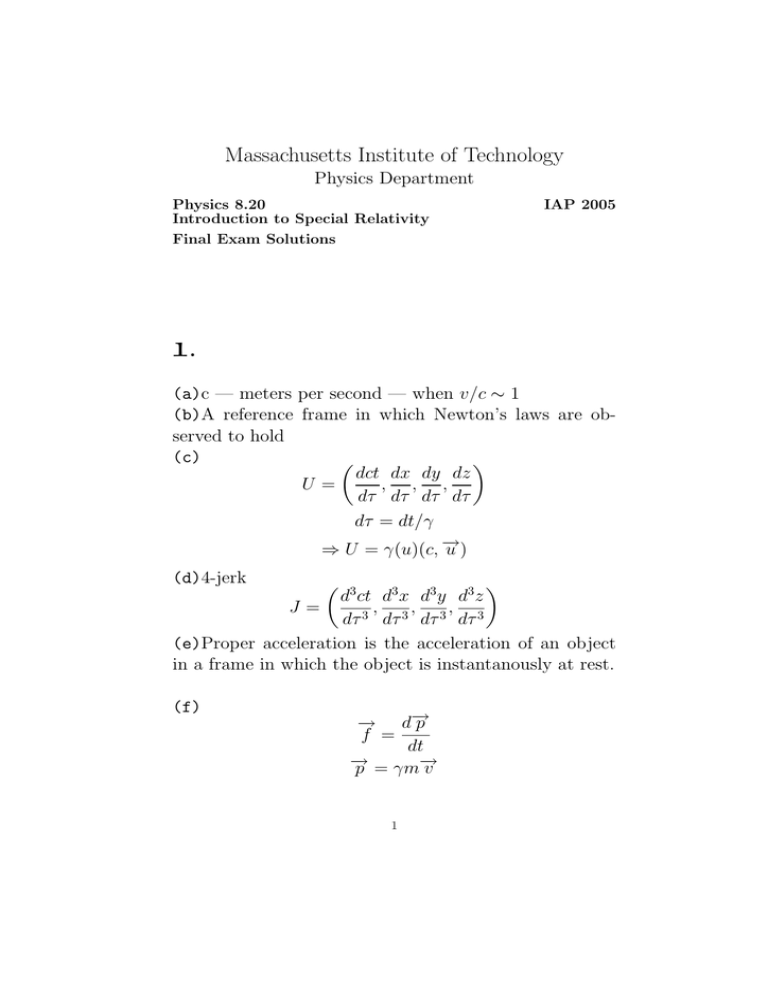
Massachusetts Institute of Technology Physics Department Physics 8.20 Introduction to Special Relativity Final Exam Solutions IAP 2005 1. (a)c — meters per second — when v/c ∼ 1 (b)A reference frame in which Newton’s laws are ob­ served to hold (c) � � dct dx dy dz U= , , , dτ dτ dτ dτ dτ = dt/γ → ⇒ U = γ(u)(c, − u) (d)4-jerk � � d3 ct d3 x d3 y d3 z J= , , , dτ 3 dτ 3 dτ 3 dτ 3 (e)Proper acceleration is the acceleration of an object in a frame in which the object is instantanously at rest. (f) → − → d− p f = dt − → → p = γm− v 1 (g) a · b = a0 b0 − a1 b1 − a2 b2 − a3 b3 (h) See figure (1) (i) See figure (1) (j) See figure (1) (k)You may write the answer in several forms: An ob­ server in a gravitational field is equivalent to an observer in an accelerated frame. Inertial mass is the same as grav­ itational mass. The laws of physics may be written such that they take the same form in all inertial frames. − → − → (l)Yes. f = ddtp (m)Michelson-Morley experiment; nearly all particle and nuclear physics data (particle lifetimes, Compton effect); the global positioning system; transverse doppler effect; conversion of mass to energy (e.g.,nuclear power); Fizeau experiment. (n)Precession of the perihelion of Mercury; the bend­ ing of light by the sun; gravitational by compact stellar objects red shift of light; correct operation of the global positioning system; Pound-Reblca experiment showing gravitational redshift on earth; time measured by clocks on a satellite compared with clocks on earth; existence of black holes. 2 8 5 4 E/c E 6 4 3 2 2 0 0.5 1 1.5 v (m/s) 2 2.5 0 3 ν/ν 0 5 4 3 2 1 −0.5 0 1 2 p x 10 6 0 −1 mc 8 Fracion of particles decaying perunit distance 0 1← ← mc2 0 0.5 β 2(g) 0.8 ← e−x/λ 0.6 0.4 0.2 0 0 2 λ 4 6 x Figure 1: Problem #1 & #2 2. τµ τµ� � ⇒ β = 1 − γ −2 τµ = γτµ� ⇒ γ = 1 γ=� 1 − β2 β = 0.95 (b) 100 MeV 3 4 1 1 (a) 3 8 10 (c)in Σ Eµ = γmµ c2 = 6.6 100 = 300 MeV 2.2 (d)in Σ KE = (γ − 1)mµ c2 = 200 MeV (e) p = γβmµ c2 /c = 3 × 100 × 0.95 = 285 MeV/c (f) Δx = βcτµ = 1881 m 4 3. 1 γ=� = 5/4 1 − β2 (a) John’s separation from George is 10 km/γ = 8 km (b)The speed of the neutrons coming from John’s gun is β+β 15 c = c 1 + β2 17 (c)The same report. (d) u�y = tan θ� � ux uy = v/2 √ 3 ux = v 2 v/2 u�y = γ(1 + ux v/c2 ) √ 3 2 v +v = 1 + ux v/c2 � � 1/2 √ ∴ θ� = tan−1 ∼ 13◦ 5/4(1 + 3/2) (e) John is firing neutrons at the rate of � 1+β = 20 kHz ν = ν0 1−β u�x 5 4. (a) xA (0)=1 AU� 1.5 × 1011 m xB (0)�1.5 AU� 2.3 × 1011 m. (b)Just rewrite the formula in the information sheet with the right initial condition, i.e xA(B) (t = 0) = xA(B) (0) � 2 c xA (t) = g 1+ � 2 c xB (t) = g � 1+ � gt c gt c �2 �2 c2 − + xA (0) g c2 − + xB (0) g (c)Lorentz contraction(See figure(2)) : AD = γAC = γ (xB (0) − xA (0)) Therefore Δx�AB = AB ≥ γl (d) xB (t) − xA (t) = xB (0) − xA (0) (e)Tangent to A’s wordline will be ct� axis of Σ� frame and x� axis will be the axis so that a light like wordline bisects the angle between the x� and ct� axis. You can choose x = x� = 0 at t = t� = 0. You can choose x = x� = 0 at t = t� = 0 and A at x� = 0 if and only if the tangent line passes through the origin. (f)See figure(2). (g) The spaceships start the same dis­ tance apart, and undergo the same acceleration (at any 6 particular time t as measured in Σ—this is crucial), so clearly they stay the same distance apart as measured in Σ.(h)In Σ� ; B starts accelerating earlier than A; and it’s accelerating faster at anytime t� . (i)No (j)No. If spaceship A and spaceship B occupy the same spacetime point in some frame Σ then they will occupy the same spacetime point also in Σ� ′ 10 xA(t) Σ xB(t) 9 B 8 D 7 ct 6 5 4 A 3 C 2 1 0 −1 0 xA(0) 1 2 x Figure 2: Problem #5 7 xB(0) 3 4 5. (a) Ep = 1000 mp c2 � β = 1 − γ −2 γ= γ −2 = 10−6 � 1 β � 1 − 10−6 /2 c − v = c(1 − β) ∼ 150 m/s ∼ 300 mi/hour (b) → → − → c2 d− p d− v |F | = | | = γmp | | = γmp v 2 /R � γmp dt dt R Note: dγ/dt = 0 since v is constant for a uniform circular motion. (c) a� = γ 2 a⊥ � γ 2 c2 /R From the information sheet, for proper acceleration per­ pendicular to the direction of motion. (d) P1 = (Ep /c, p) P2 = (mp c, 0) PX = (EX /c, pX ) P 1 + P 2 = PX (P1 + P2 )2 = P12 + P22 + 2P1 · P2 = PX2 = m2X c2 2P1 · P2 = 2mP EP = m2X c2 − 2mP2 c2 8 � mX = mP �1/2 EP 2(1 + ) = (1GeV/c2 )(2×1001)1/2 � 45GeV/c2 2 mP c (e) (Ep /c, p) + (Ep /c, −p) = (mX c, 0) Compare zeroth element of LHS and RHS: mX = 2EP /c2 = 2 TeV/c2 (f)(ii) since 2 TeV/c2 is greater than supposed mX . (g) In this case, 2Ep /c2 (20%) = 400 GeV. We therefore probably need to build a collider (iii). It sure would be nice to know a “few hundred GeV” more precisely. 9


